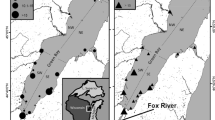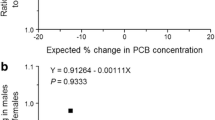Abstract
Total polychlorinated biphenyl concentrations (ΣPCBs) in whole fish were determined for 18 ripe female burbot Lota lota and 14 ripe male burbot from Great Slave Lake, a lake with no known point sources of PCBs. In addition, ΣPCBs were determined in both somatic tissue and gonads for a randomly selected subset of 5 females and 5 males. Mean ΣPCBs for females and males were 2.89 and 3.76 ng/g, respectively. Thus, males had 30 % greater ΣPCBs than females. Based on ΣPCB determinations for somatic tissue and gonads, ΣPCBs of females and males would be expected to decrease by 18 % and increase by 6 %, respectively, immediately after spawning due to the release of gametes. Results from a previous study in eastern Lake Erie indicated that males had 28 and 71 % greater ΣPCBs than females from populations of younger (ages 6–13 years) and older (ages 14–17 years) burbot, respectively. Thus, although younger burbot from Lake Erie had approximately 50 times greater ΣPCBs than Great Slave Lake burbot, the relative difference in ΣPCBs between the sexes was remarkably similar across both populations. Our results supported the contention that the widening of the difference in ΣPCBs between the sexes in older burbot from Lake Erie was attributable to a “hot spot” effect operating on older burbot because Lake Erie has received PCB point source loadings. Our results also supported the contention that male fish expend energy at a rate between 15 and 30 % greater than females. Eventually, these results will be useful in developing sex-specific bioenergetics models for fish.



Similar content being viewed by others
References
Ballschmiter K, Bacher R, Mennel A, Fischer R, Riehle U, Swerev M (1992) The determination of chlorinated biphenyls, chlorinated dibenzodioxins, and chlorinated dibenzofurans by GC-MS. J High Resolut Chromatogr 15:260–270
Borgmann U, Whittle DM (1992) Bioenergetics and PCB, DDE, and mercury dynamics in Lake Ontario lake trout (Salvelinus namaycush): a model based on surveillance data. Can J Fish Aquat Sci 49:1086–1096
Carlson DL, De Vault DS, Swackhamer DL (2010) On the rate of decline of persistent organic contaminants in lake trout (Salvelinus namaycush) from the Great Lakes, 1970–2003. Environ Sci Technol 44:2004–2010
Cott PA (2011) Life history and reproductive ecology of a mid-winter spawner: The burbot (Lota lota). Dissertation, Laurentian University, Ontario, Canada
Cott PA, Johnston TA, Gunn JM (2013a) Sexual dimorphism in an under-ice spawning fish: the burbot (Lota lota). Can J Zool 91:732–740
Cott PA, Johnston TA, Gunn JM (2013b) Stability in life history characteristics among burbot populations across environmental gradients. Trans Am Fish Soc 142:1746–1756
Edwards WH, Stapanian MA, Stoneman AT (2011) An evaluation of precision in age estimation of two treatments of otoliths from an aging burbot population. J Appl Ichthyol 27(Suppl 1):43–48
Evans MS, Muir D, Lockhart WL, Stern G, Ryan M, Roach P (2005) Persistent organic pollutants and metals in the freshwater biota of the Canadian Subarctic and Arctic: an overview. Sci Total Environ 351–352:94–147
Frame GM, Cochran JW, Boewadt SS (1996) Complete PCB congener distributions for 17 Arochlor mixtures determined by 3 HRGC systems optimized for comprehensive, quantitative, congener-specific analysis. J High Resolut Chromatogr 19:657–668
International Union of Pure and Applied Chemistry (IUPAC) (2012) Recommendations on organic & biochemical nomenclature, symbols & terminology etc. Available at: http://www.chem.qmil.ac.uk/iupac/. Accessed: March 2014
Jude DJ, Rediske R, O’Keefe J, Hensler S, Giesy JP (2010) PCB concentrations in walleyes and their prey from the Saginaw River, Lake Huron: a comparison between 1990 and 2007. J Great Lakes Res 36:267–276
Larsson P, Okla L, Collvin L (1993) Reproductive status and lipid content as factors in PCB, DDT, and HCH contamination of a population of pike (Esox lucius L.). Environ Toxicol Chem 12:855–861
Madenjian CP (2011) Sex effect on polychlorinated biphenyl concentrations in fish: a synthesis. Fish Fish 12:451–460
Madenjian CP, Elliott RF, DeSorcie TJ, Stedman RM, O’Connor DV, Rottiers DV (2000) Lipid concentrations in Lake Michigan fishes: seasonal, spatial, ontogenetic, and long-term trends. J Great Lakes Res 26:427–444
Madenjian CP, Hanchin PA, Chernyak SM, Begnoche LJ (2009) Sexual difference in PCB concentrations of walleyes (Sander vitreus) from a pristine lake. Sci Total Environ 407:4526–4532
Madenjian CP, Keir MJ, Whittle DM, Noguchi GE (2010a) Sexual difference in PCB concentrations of lake trout (Salvelinus namaycush) from Lake Ontario. Sci Total Environ 408:1725–1730
Madenjian CP, Schrank CS, Begnoche LJ, Elliott RF, Quintal RT (2010b) Sexual difference in PCB concentrations of coho salmon (Oncorhynchus kisutch). Sci Total Environ 408:1719–1724
Madenjian CP, Stapanian MA, Rediske RR, O’Keefe JP (2013a) Sex difference in polychlorinated biphenyl concentrations of burbot Lota lota from Lake Erie. Arch Environ Contam Toxicol 65:300–308
Madenjian CP, Johnson NS, Binder TR, Rediske RR, O’Keefe JP (2013b) Polychlorinated biphenyl concentrations and activity of sea lamprey Petromyzon marinus vary by sex. Arch Environ Contam Toxicol 65:793–803
Mudroch A, Allan RJ, Joshi SR (1992) Geochemistry and organic contaminants in the sediments of Great Slave Lake, Northwest Territories, Canada. Arctic 45:10–19
Neter J, Kutner MH, Nachtsheim CJ, Wasserman W (1996) Applied linear statistical models, 4th edn. Irwin, Chicago
Niimi AJ (1983) Biological and toxicological effects of environmental contaminants in fish and their eggs. Can J Fish Aquat Sci 40:306–312
Preddice TL, Jackling SJ, Skinner LC (2002) Contaminants in young-of-year fish from near-shore areas of New York’s Great Lakes Basin, 1997. New York State Department of Environmental Conservation, Albany
Schmidt LJ, Hesselberg RG (1992) A mass spectroscopic method for analysis of AHH-inducing and other polychlorinated biphenyl congeners and selected pesticides in fish. Arch Environ Contam Toxicol 23:37–44
Stapanian MA, Madenjian CP, Tost J (2007) Regional differences in size-at-age in the recovering burbot population in Lake Erie. J Great Lakes Res 33(Suppl 1):91–102
United States Fish and Wildlife Service (2002) Natural resource damage assessment plan for the Ashtabula River and Harbor. USFWS Region 3, Fort Snelling. Available at: http://www.fws.gov/midwest/es/ec/nrda/ashtabularivernrda/documents/AshAP.pdf. Accessed: November 2013
Wang J, Bai X, Hu H, Clites A, Colton M, Lofgren B (2012) Temporal and spatial variability of Great Lakes ice cover, 1973–2010. J Clim 25:1318–1329
Weininger D (1978) Accumulation of PCBs by lake trout in Lake Michigan. Dissertation, University of Wisconsin, WI
Acknowledgments
We thank Nicola Johnson, Morag McPherson, Sarah Elsasser, Sarah Olivier, Rick Walbourne, Barry Zajdlik, and Bruce Hanna for assisting with the capture of burbot from Great Slave Lake; Bill Edwards and Richard Kraus for determining ages of the burbot; Tim Desorcie, Lynn Ogilvie, and Justin Mychek-Londer for assisting with the homogenization of burbot tissue; Devi Haria and Sarah Stamann for assisting with the fish tissue extractions; and Holly Muir for reviewing the draft manuscript. Use of trade, product, or firm names does not imply endorsement by the United States Government. This article is Contribution 1833 of the United States Geological Survey Great Lakes Science Center.
Author information
Authors and Affiliations
Corresponding author
Rights and permissions
About this article
Cite this article
Madenjian, C.P., Stapanian, M.A., Cott, P.A. et al. Polychlorinated Biphenyl Concentrations of Burbot Lota lota From Great Slave Lake Are Very Low but Vary by Sex. Arch Environ Contam Toxicol 66, 529–537 (2014). https://doi.org/10.1007/s00244-014-0015-9
Received:
Accepted:
Published:
Issue Date:
DOI: https://doi.org/10.1007/s00244-014-0015-9




